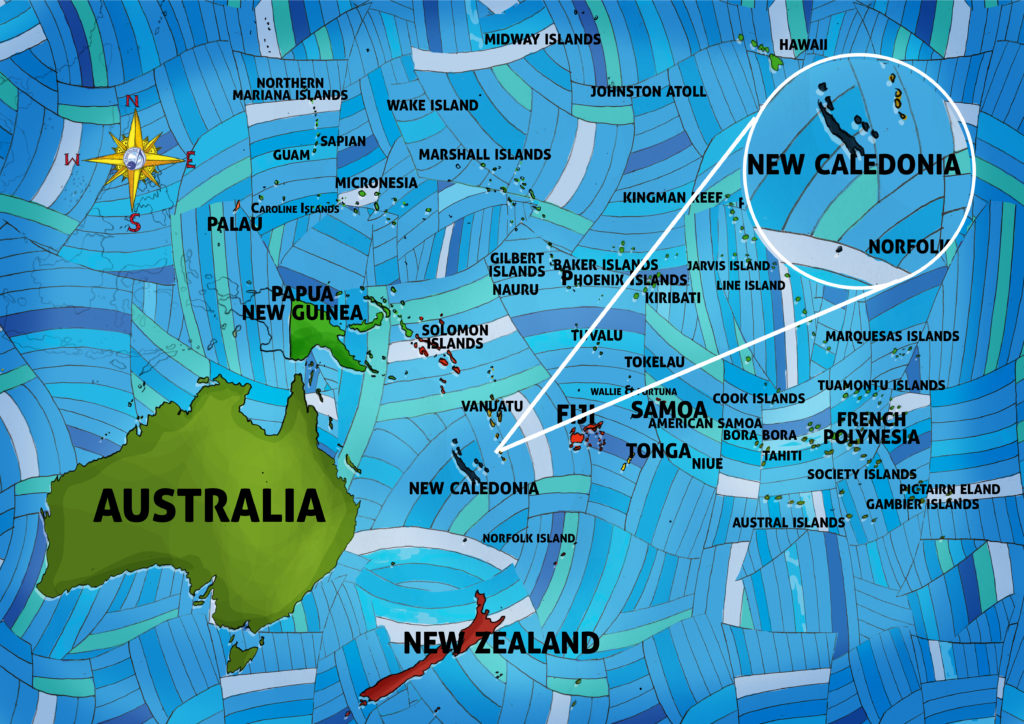Yesterday we learned about the New Caledonian narrative dance tradition of “Pilou.” In this video we catch a contemporary spin on the tradition, performed by New Caledonian musician Tim Sameke. Watch Sameke’s “pilou dancers” hop, spin and shake their straw.
Tag Archives | New Caledonia
New Caledonian Pilou Pilou
In our online class we experience New Caledonia’s “pilou” dance — our very simple, conceptual version of it, anyway. Each pilou tells a particular Kanak story, whether of a birth, marriage, great battle or even the arrival of missionaries. While the term “pilou-pilou” encompasses many kinds of pre-colonial Kanak ceremonies, the pilou dance itself is a “round-dance” that traditionally involves many people moving together around a central pole, sometimes for hours at a time. New Caledonian pilou dancers’ feet make a “sh-sh-sh-sh” sound as the dancers move from foot to foot, hopping on one foot while stamping the other. Sometimes dancers hold straw which sways as the body shifts from side do side. The French colonial authorities banned pilou in the mid-20th century because they feared the trances Kanaks entered while dancing, but in class we love trances! So, we pilou.
All in for Edou
Yesterday we learned about “Kaneka,” a New Caledonian music that mixes traditional Kanak folk music with global pop. Edou, “Millio” Edou, a member of the Drueulu Tribe which is based in the Lifou (Loyalty Islands), rose to New Caledonian popularity in the mid-80s and went on to tour the Pacific Islands and beyond with his inventive form of kaneka-reggae. When the reviewer who wrote National Geographic World Music’s profile of Edou saw Edou perform at the South Pacific music festival, the artist’s “first rate” band included New Caledonia’s minister of culture. Fortunately, “The minister can really jam.” Watch from on-stage as Edou and his first rate band perform live.
Gurejele’s Kaneka
The traditional/folk music of New Caledonia features vocal chants and instruments like log drums. Modern musicians from New Caledonia have adopted guitars and keyboards and have embraced global genres like rock and reggae. Still, when they go back to their roots, they find those roots in the percussion and chants of their Melanesian forefathers. As the New Caledonian independence movement rose in the mid 1980s, so rose a genre known as “kaneka,” which fuses the traditional music of the indigenous New Caledonian people with global world pop. Let’s enjoy some Kaneka — “Waipeipeigu” by Gurejele.
Come with us to Kanaky (a.k.a. New Caledonia)

This week in our online classes we visit the Melanesian island nation of New Caledonia. Also known as Kanaky, New Caledonia is, in many ways, a very surprising place. Nicknamed “Le Caillou (The Stone),” the surface of this Melanesian archipelago’s main island, Grand Terre, is essentially composed of nickel, chromium, magnesium, and manganese, a mix that should be toxic to plants. In New Caledonia, it’s not. In New Caledonia, plants that should not technically be able to survive have developed specific mechanisms that allow them to cope with, even to thrive in, such harsh conditions. Looking at the history of New Caledonia, one may say the same about the island nation’s indigenous Kanak people. French colonization of New Caledonia was harsh. There was economic and physical exploitation, there was apartheid-like segregation and forced relocation to Kanak-only reservations…at many turns Kanak population could easily have disappeared. The fact that today the Kanaks are the main political force in potentially-soon-to-be-independent New Caledonia is a testament to their unique survival instinct.

